Crocodilians are fascinating and giant reptiles, but what are their differences, and how can we tell them apart? Half of the 23 living species in 90 countries worldwide are dangerous to people when hungry or defending their territory and young. Looking at the different crocodilian families brings up interesting facts.
Alligators, crocodiles, and gharial are three different families in the Crocodilian order, with caiman as a sub-species of alligators. The families differ physically, with some species large, semi-aquatic, carnivorous, or aquatic, like the gharial. Their snouts are a key distinction.
Crocodilians, to which alligators, crocodiles, caiman, and the gharial belong, are the world’s only surviving archosaurs. Or, the living reptiles classed alongside dinosaurs date almost 250 million years ago.
The evolved forms of these top predatory reptiles are classified by their habitats, size, and appearances. Each, however, bears the imprint of their specific ancient ancestry.
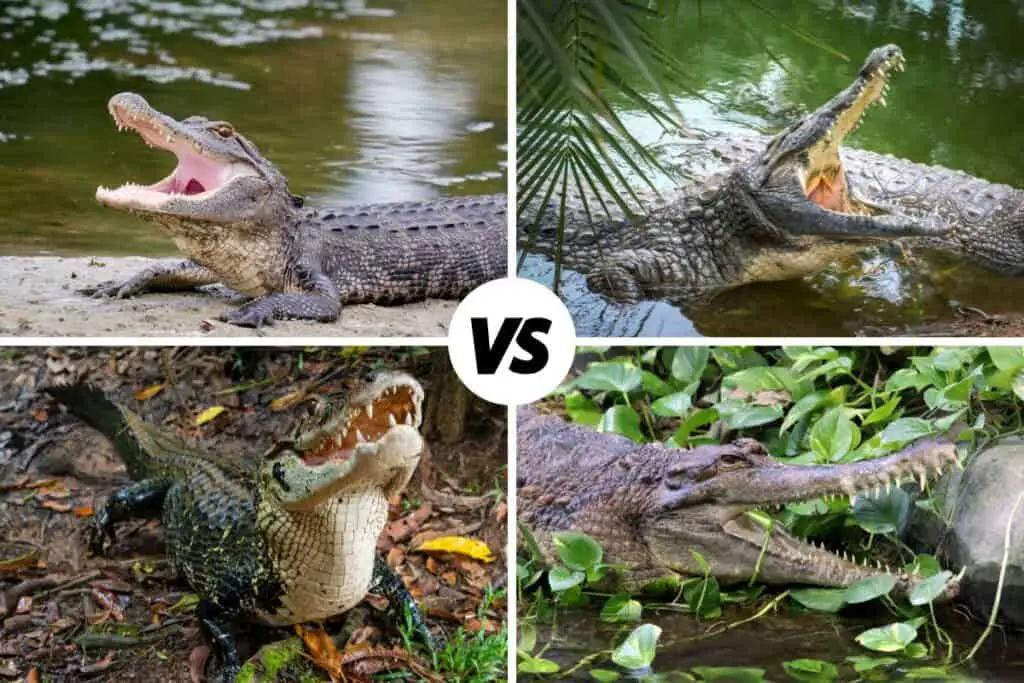
Alligator vs Crocodile vs Caiman vs Gharial
Ever noticed how easily we use the word crocodile for all the reptilian lizards that make up the crocodilian order? We easily throw in alligators or ‘gators,’ caiman, and gharials in the crocodile catchall phrase calling their crocodiles.
We disregard that crocodilians are the larger order for several families of reptiles. Within the order of crocodilians, we find different-sized and different-looking reptiles with webbed feet, enormous tails, different shapes, strengths and lengths of snouts, and scales and scutes.
Despite the overall classification, crocodilians fill us with basic fear as these beasts sit at the top of the world’s predators list. Take a step back, as these frightening creatures are evolutionary wonders, robust survivors from the dinosaur age.
The cold-blooded vertebras come into the world via an egg and live in tropical regions, each adapted to their specific environments. Alligators, crocodiles, caiman, and gharial have outlasted the dinosaurs. And these cold-blooded reptiles still carry the extraordinary imprints of millennia.
Their skin is protected by scales known as scutes, sets of hard fibrous and protein-rich keratin scales on their backs. These bony scales or scutes are more complex than those on snakes and lizards and form a tough spikey coat of armor.
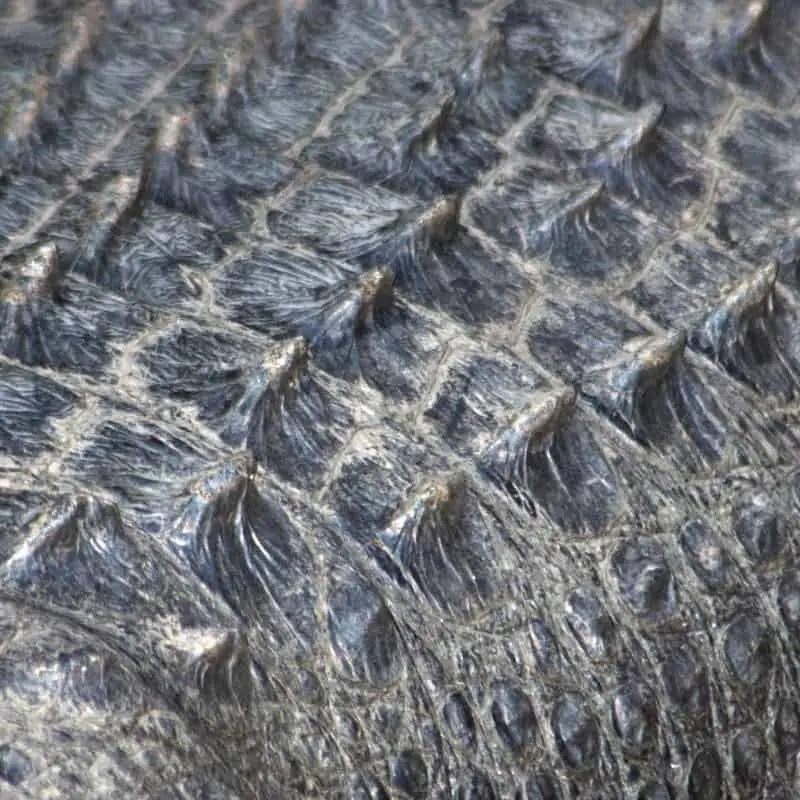
Crocodilian Appearances
All crocodilians have the same basic appearance; those long solid bodies with laterally compressed tails stand out. And distinctive features that indicate differences are their short U-shapes and longer V-shaped or drawn-out snouts.
The habitant of the crocodilian families stands out as much as their physical features.
Alligator, Crocodile, Caiman, And Gharial: Families
Alligators, crocodiles, caiman, and gharial belong to three families in the Crocodilian order known as Alligatoridae (alligators), Crocodylidae (true crocodiles), and the Gavialidae (gharial). The families are based on these species’ last common ancestors. Within the family of the Alligatoridae, there is a sub-family, the Caimaninae.
So, when considering alligators, crocodiles, caiman, and gharial, the four groupings under the uber-classification of Crocodilian come into play. These species in the Crocodilian order have common ancestral origins dating to the Mesozoic Period when the Tyrannosaurus rex roamed.
But crocodiles, alligators, caiman, and gharial aren’t dinosaurs, and there are differences between their species. The crocodilian species is the last surviving archosaurian reptile. What happened was that one-half of the archosaur evolved into the oldest relatives of crocodiles and alligators.
The other became the dinosaur, birds, and flying reptiles (the pterosaurs). That was about 250 million years ago and in the Triassic period, after which a mass extinction left the crocodilians as the only surviving archosaurs.
In the early stages of evolution, crocodilians were:
- Either entirely on the ground (terrestrial)
- Or in water (aquatic)
- Or, like today’s semi-aquatic creatures
The evolved archosaur type, the crocodilians, differs where we find them. Their size, physical look, and how they adapt anatomically are different too.
So, what we know today is that there are different biological families in the larger Crocodilian order:
- Alligatoridae which is a grouping of alligators and includes the sub-family: caimans
- Crocodylidae includes all crocodiles
- Gavialidae in which gharial or gavial fits, and an additional overlapping gavial Crocodylidae grouping
Thinking about Crocodilians brings up strong emotions as these are feared predators. At the same time, crocodilians must be admired as the survivors of a prehistoric era as far back as the dinosaurs. With the dinosaurs’ extinction came the long reign of the Crocodilian order. And today, we can marvel at the different species in this order.
What follows is a breakdown of each of these families’ roots.
Alligators: Morphology
The genus alligator covers large reptiles in the Crocodilia order that make up the family Alligatoridae with two living species:
- American alligator (A. mississippiensis)
- Chinese alligator (A. Sinensis)
Alligator is derived from the Spanish el largato for ‘lizard’. The family split between 53 and 65 million years ago; the Alligotoridae family split into alligators and caimans. Around 33 billion years ago, the Chinese alligator split from the American alligator.
The modern American alligator has evolved slower. And a subfamily includes the sister taxon Caimaninae (the caimans).
The alligators are characteristically black or dark olive-brown with white undersides. Their younger offspring have yellow or whitish stripes contrasting with their dark hides.
In size, the American alligator weighs between 790 – 990 lbs and is between 13 – 19 feet long. In comparison, the Chinese alligator is smaller and rarely is longer than 7 feet (and weighs about 100 lbs).
The alligator’s outward appearance is a form of camouflage that works well when these giant lizards are hidden amongst reeds and wetland grasses. Be warned that some American gators have a habit of climbing trees – not for sunbathing, but for a higher view from where to leap down on prey in a flash.
American alligators are found in ponds, marshes, rivers, and wetlands (lakes and swamps), feeding on semi-aquatic rodents like the coypu.
During mating season, the male alligators bellow loudly before sunrise and gather during spring at sunset. The females build the nest and watch their young hatch – each hatchling grows an egg tooth to help them emerge. The mothers keep guard, and cannibalism from adult alligators over young does happen.
Alligators have a subset or sub-family, the caiman (see below).
Caiman: Morphology
Alligators and caiman families split about 53 – 63 million years ago. Now, the Caimaninae is a subfamily of the primary Alligotoridae family.
Their habitats differ from the caimans in Mexico, Central, and South America. Still, both are found in marshes and mangrove swamps, along rivers, and in lakes. Caimans are nocturnal and relatively small-sized crocodilians and have scaly skin.
The largest caiman species is the black caiman that lives in the Amazon basin’s rivers and lakes. On average, caimans are 6 – 13 feet long and weigh about 88 lb.
There are exceptions, though, like the black caiman – 15-plus feet long and weighing more than 2000 Ib. In contrast to the enormity of the black caiman, there’s the Cuvier’s dwarf between 3.9 – 4.9 feet long.
Caimans, as closest relatives of alligators, differ in the following ways:
- No bony septum between the nostrils
- Overlapping bony scutes
- Longer and sharper teeth than alligators
- More agile than alligators
- Have movements that are crocodile-like
Besides the above differences, caiman’s hides are stiffer than those of alligators. Like alligators, caimans’ snouts are U-shaped, and they’re known as ferocious predators.
Sadly, humans are caimans’ main predators, and caiman is hunted for their meat and skins. Jaguars and anacondas are caiman predators, too – specifically, the smaller ones are hunted. In dry summer months, caiman hibernate in burrows.
Caiman, like alligators, crocodiles, and gharials, lay eggs. The female caimans build the nests – these nests are large and up to almost 5 feet wide. There are 10-50 eggs in a nest with an incubation period of about six weeks. The mother takes the hatchlings to a shallow pond where they hunt and swim.
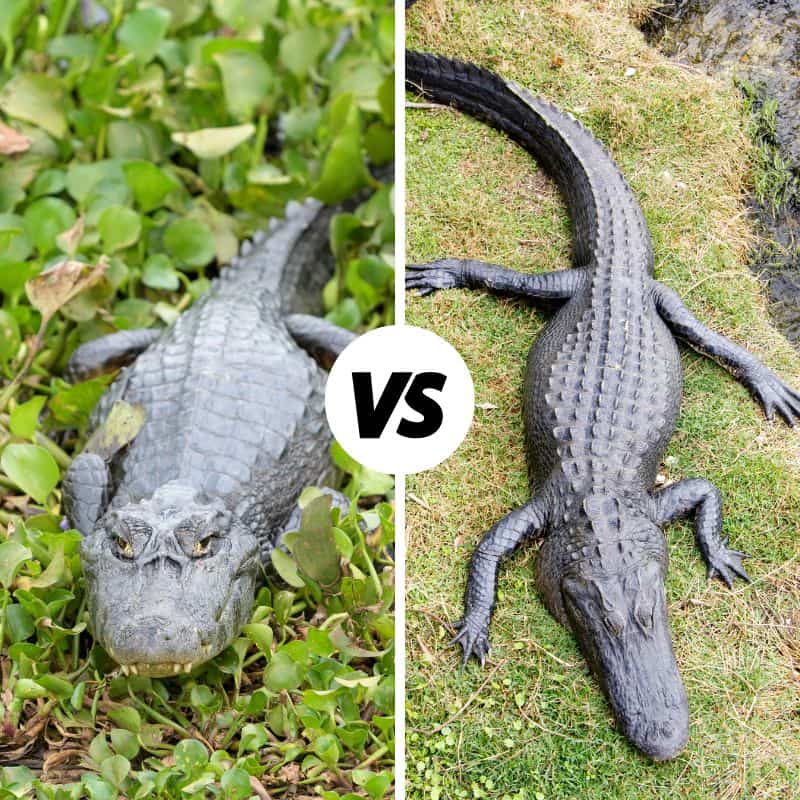
Crocodiles: Morphology
Crocodiles are giant and semiaquatic reptiles found in the tropics in Africa, Asia, the Americas, and Australia. The apparent difference is the morphological differences between alligators and crocodiles with U- and V-shaped snouts. Compared to alligators and crocodiles, gharials have long, thin snouts.
Crocodiles vary in size and can be found in rivers, lakes, wetlands, brackish, and saltwater.
Crocodiles are carnivorous, eat fish, reptiles, birds, and mammals, and are found in the tropics – crocodiles are suited to warmer regions, unlike alligators, which are found in colder areas too. If you’re crocodile spotting, you’ll likely find them basking in the sun.
There are 18 species of crocodiles found in different tropical regions – some with shorter V-shaped snouts and others longer, some in fresh water and others in salty.
The largest living crocodile is also the fiercest and is found in southeast Asia and northern Australia and is known as the saltwater crocodile.
The Cuban crocodiles, much smaller, are also known to be extremely vicious.
The physical traits of crocodiles – from small to larger ones – make them ferocious predators. Their bodies are streamlined, and they swim fast. Their muscular tails let them swim powerfully, and the webbing between their toes also helps with speed. Remarkably, the saltwater croc can glide at just under 10 miles per hour. And double that speed for short bursts.
On land, crocodiles are less agile and have two styles of walking:
- High – lifting their trunks off the ground and moving at a slow gate
- Low – like crawling on their legs and belly, a splayed-out and sliding motion
To gain speed on land, crocodiles do a low walk faster, and the Australian freshwater crocodile can run at a speed of over 10 miles per hour.
Warning: crocodiles are on land and in the water!
Crocodile size, morphology, and behavior differ from the other crocodilian species. There are similarities, like being semiaquatic like alligators and caiman. Crocodiles congregate next to rivers, lakes, wetlands, and even brackish or saltwater.
Alligators and caiman are not equipped to be in salt water, but gharials are.
Crocodiles are tropical species that are not found in cold terrains, unlike alligators. Crocodiles are carnivorous – they eat fish, reptiles, birds, and mammals, but also mollusks and crustaceans.
Curiously, crocodiles don’t sweat and keep their mouths open to keep their bodies cool.
Gharials: Morphology
Gharials are also known as gavial or fish-eating crocodiles – a significant distinction between this kind of Crocodilian and alligators and crocodiles.
Of the family Gavialidae, these are the longest of all living crocodilians. The females or cows can be between 8 ft 6 in and 14 ft 9 long. And the males or bulls are between 9 ft 10 in and 19 ft 8 in.
A distinct morphological feature is the long thin snout of gharials and the knob at the tip of bulls’ snouts. The knob looks like an earthenware pot called a ghara. That’s why the name gharial is used for this Crocodilian species. The snout is also long and narrow, with 110 sharp, interlocking teeth.
Gharials are found in northern India, are aquatic, and only come out of the water to bask in the sun or build nests on moist sandbanks. The females also prepare the nests, with 20–95 eggs in a nest. The female guards the nest, and the young, that hatch before the monsoon season.
One of the biggest threats to gharials is humans, who use their body parts as medicine.
Evolutionarily, it’s unclear how the gharial came about, especially considering the morphology of alligators, crocodiles, and caiman. It is thought that gharials evolved from earlier species as their skull shape, long and narrow snout, and even partially webbed fingers and toes differ.
Also, the hollow bulbous nasal knob on the male’s snout is about one inch high and just over 2 inches in diameter. In mating season, this morphological structure allows males to make a hissing sound that can travel close to 250 feet.
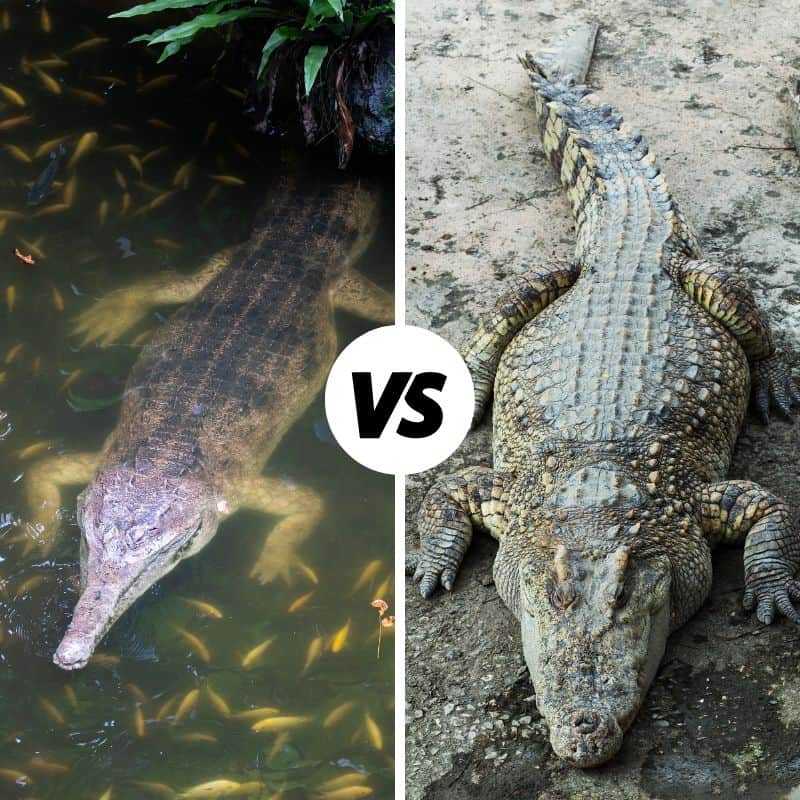
Alligators, Crocodiles, Caiman, And Gharial: Shape Of Snout
The snout of alligators, crocodiles, caiman, and gharial is a dead giveaway of their species; the shapes and length of these snouts are distinguishing features:
- Alligators have broad and short, and rounded U-shaped snouts
- Crocodiles’ snouts are comparatively longer, pointy, and V-shaped
- Caimans are smaller than crocodiles and have a rounded U-shaped snout like an alligator
- Gharials have long, narrow snouts
The snouts of alligators, caiman, and crocodiles are U, and V-shaped, but the gharial stands out. The gharial’s snout is well-adapted to catching fish and is long and narrow.
And males have a boss at the end that resembles an earthenware pot, or ghara as it’s called. The pot at the tip of the caiman’s snout produces hissing sounds used in mating rituals.
The mugger crocodile doesn’t have the distinctive V-shaped snout. The mugger’s snout is rounded, which shows there are many exceptions.
Alligators Differ From Crocodiles
As said above, it’s harder to spot the differences between alligators and crocodiles than to see how they differ from gharials.
The differences between close relatives, like the crocodile and the alligator, can be seen when one looks at these giant lizards; some are scientifically detected.
Visible differences are:
- Teeth
- Shape of Jaw
Scientific differences are:
- Salt glands
- Sense receptors
The teeth of alligators and crocodiles stand out, and these are a marker of their species – either exposed or interdigitated teeth – like the fingers of two clasped hands. The teeth on an alligator’s jawline don’t stick out.
An alligator’s teeth on the lower jaw fit into the sockets of the upper jaw. The upper teeth are visible when their snouts are closed.
The differences between alligators’ and crocodiles’ teeth are evident when their snouts are shut. In contrast, the teeth on a crocodile’s lower jaw fit into grooves outside the top jaw.
Both the upper and the lower sets of teeth stick out. The best way to describe the look of a crocodile’s jagged teeth is as a toothy grin!
The shape of alligators’ and crocodiles’ jaws also differs, with alligators’ wider and U-shaped ones. The shape of alligators’ jaws is to crack open the hard shells of turtles, amongst others. Crocodiles’ jaws are pointy and V-shaped.
Scientists have found that crocodilians have modified salivary glands. Crocodiles, alligators, caiman, and gharial have salt glands on their tongues.
In the case of crocodiles and gharials, these glands excrete salt. This is not the same for alligators and caiman who have lost the ability. That’s why crocodiles can venture into saline water and migrate through it.
Alligators and caiman, on the contrary, are restricted to freshwater areas like tidal mangrove swamps and are rarely seen in coastal areas.
Besides the salt glands, crocodiles and alligators also have receptors on the skin around their upper and lower jaws to detect changes in the water. This means that the sensitivity of these receptors can help them get hold of nearby prey.
What we do know about crocodiles is that 6 out of the 23 species are dangerous to humans. Crocodiles are also considered more aggressive than alligators, especially the Nile crocodiles and the saltwater ones.
They can better tolerate saltwater due to specialized salt glands for filtering out salt, which alligators have but have also lost their function. Crocodiles are much more aggressive than other types of crocodilians.
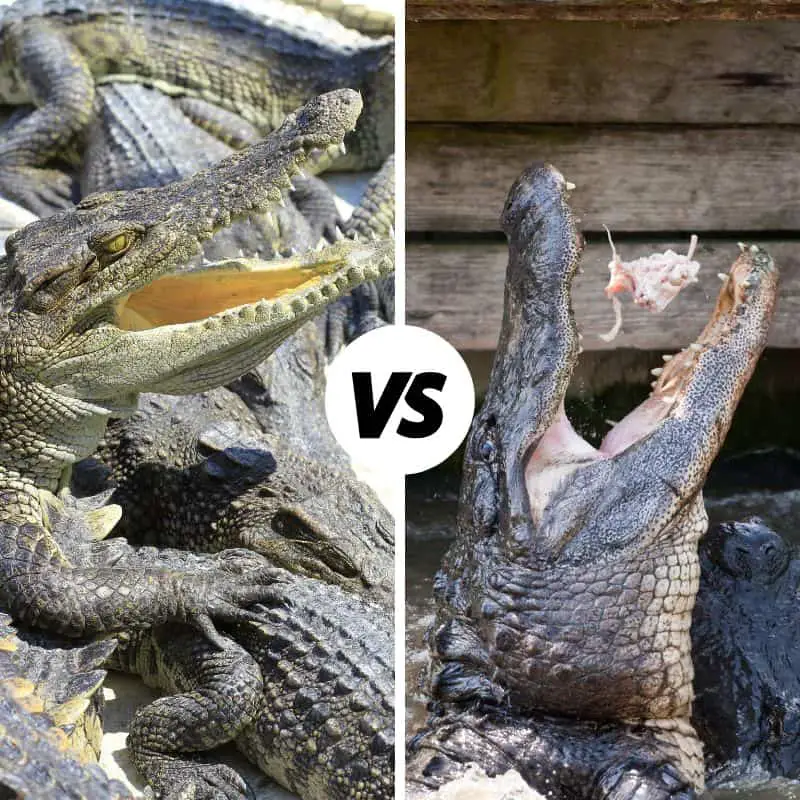
Final Thoughts On Crocodilian Differences
The four families in the Crocodilian order have survived millions of years and, despite being feared, have humans as one of their greatest predators.
Much of their vulnerability is connected to habitat loss – even these apex predators are not guaranteed their safety or immunity.
The most significant differences between alligators, crocodiles, caimans, and gharial are their physical locations, size, and semi-aquatic and aquatic behavior.
But definitely, the shape of their snouts indicates their different feeding habits.
Alligators, crocodiles, and caiman are semiaquatic, and gharials are aquatic – seldom leave the water other than basking in the sun.
